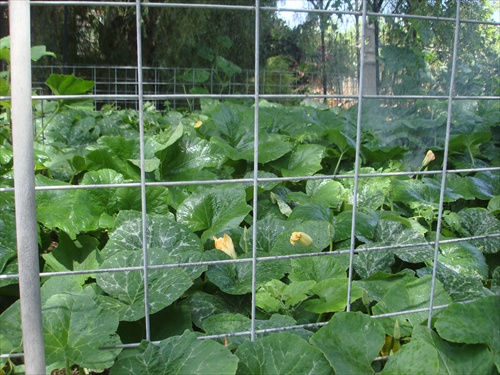Where’s the Great Pumpkin Charlie Brown?
Our pumpkin and squash patch is spilling over its fencing—literally. I had no idea when I planted those small 4” pots, started from seed in early spring that they would run so far and so high. Some have attached their tendrils to low hanging branches and are climbing up into a tree, over fences, and around anything they can latch on to.
On the positive side, though, I don’t have to worry about not being able to read the plant markers anymore. The fruit has grown large enough that I can see more than a dozen Butternut Squash, Delicata, Sweet Dumplings, and a few mysterious ones I don’t recognize. I’ve forgotten the names of everything I planted all those months ago.
The only thing I can’t see is very many pumpkins. In this patch I planted Connecticut Field pumpkins and search as I may I only see a few perfectly round globes. October and November just wouldn’t be right without the glow of a carved pumpkin on the front walk. Just like inside the house would not be as festive without a collection of Sugar Pie pumpkins at every turn. Not to mention the aroma of pumpkin butter perking away in the crockpot or a harvest pumpkin bread hot from the oven. Wouldn’t be fall at all without those orange orbs.
But, not to worry, it will be harvest time soon enough and I’ll have a bushel of winter squash for soup, stews and just plain baking and eating, and there will be pumpkins for cooking and decorating even if there are only a few. Fall wouldn’t be the season I love without pumpkins and squash. Nope, not at all.
Why so few pumpkins?
Well, according to my good friend Sandy, a small pumpkin crop is the result of not enough Pumpkin Sex in the morning. You heard that right, folks…Pumpkin Sex!
Pumpkins (like other squash) have boy flowers and girl flowers, and in order for the girl flower to set fruit (grow baby pumpkins) she has to be fertilized or pollinated. You remember the birds and the bees, right?
Unfortunately, what use to be the springtime job of bees has now been relegated to us humans. And why shouldn’t it, we humans have been the primary cause of decreasing the bee population all over the country with our chemicals and pesticides and unfriendly bee practices.
So, instead of bees hoping from flower to flower spreading pollen where ever they land we must now take over that task.
Making pumpkin babies is really very simple. First you identify the boy flowers, which will have a stamen in the center of the flower. Think male parts and you won’t have any trouble identifying them. The female flower has “girl parts” or a multi-segmented stigma. This is where the pumpkin will start growing once the female flower has been pollinated. When you find a male flower, gently pick it and pull down or remove the pedals to expose the stamen. Then gently open the female flower and swirl the stamen around the stigma to transfer the pollen. You can also use a Q-tip or your finger to transfer the pollen from one flower to another, but that all seems just a bit too personal. In a day or so the female flower will close up and begin to dry, exposing its “baby bump”. Or is that “baby pump”? After about five days the little pumpkin has grown exponentially, proof that the morning pollination was a success and that Pumpkin Sex in the spring means loads of pumpkins come fall. After that just sit back and watch your pumpkins grow.
Note to self, folks, if engaging in early morning Pumpkin Sex isn’t quite up your alley start planting bee attracting flowers and shrubs so that Mother Nature can take back HER job.

Recent comments
Aenean nonummy hendrerit mauris. Phasellus porta.